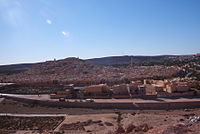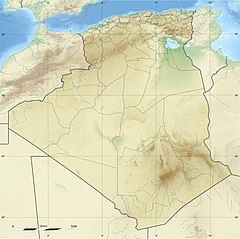Ghardaïa District
|
Taghardaïat غرداية / taƔerdayt |
|
|---|---|
| city | |
| City of Ghardaïa | |

Panoramic view of Ghardaïa (Tagherdayt) with the dry bed of Wadi Mzab on the right side.
|
|
 Location of the city of Taghardaïat within Taghardaïat Province |
|
| Location of Taghardaïat within Algeria | |
| Coordinates: 32°29′N 3°40′E / 32.483°N 3.667°ECoordinates: 32°29′N 3°40′E / 32.483°N 3.667°E | |
| Country |
|
| Province | Taghardaïat (seat) |
| District | Taghardaïat (coextensive) |
| Founded | 1048 |
| Government | |
| • PMA Seats | 15 |
| Area | |
| • Total | 590 km2 (230 sq mi) |
| Elevation | 572 m (1,877 ft) |
| Population (2008) | |
| • Total | 142,913 |
| • Density | 240/km2 (630/sq mi) |
| Time zone | CET (UTC+01) |
| Postal code | 47000 |
| ONS code | 4701 |
| UNESCO World Heritage Site | |
|---|---|
| Location |
Ghardaïa Province, Algeria |
| Coordinates | 32°29′N 3°40′E / 32.48°N 3.67°E |
| Area | 590 km2 (6.4×109 sq ft) |
| Criteria | ii, iii, v |
| Reference | 188 |
| Inscription | 1982 (6th Session) |
|
[]
|
|
Ghardaïa (Arabic: غرداية, Mzab-Berber: taƔerdayt, Taɣerdayt) is the capital city of Ghardaïa Province, Algeria. The commune of Ghardaïa has a population of 93,423 according to the 2008 census, up from 87,599 in 1998, with an annual growth rate of 0.7%. It is located in northern-central Algeria in the Sahara Desert and lies along the left bank of the Wadi Mzab. The M'zab valley in the Ghardaïa Province (Wilaya) was inscribed under the UNESCO World Heritage List in 1982, as a cultural property evaluated under the criteria II (for its settlement affecting urban planning even to the present century), III (for its Ibadi cultural values), and V (a settlement culture which has prevailed to the present century).
Ghardaïa is part of a pentapolis, a hilltop city amongst four others, built almost a thousand years ago in the M’Zab valley. It was founded by the Mozabites, a Muslim Ibadi sect of non-Arabic Muslims, including the Berbers. It is a major centre of date production and the manufacture of rugs and cloths. Divided into three walled sectors, it is a fortified town. At the centre is the historical Mʾzabite area, with a pyramid-style mosque and an arcaded square. Distinctive white, pink, and red houses, made of sand, clay and gypsum, rise in terraces and arcades. In her 1963 book, La force des choses the French existentialist philosopher Simone de Beauvoir described Ghardaïa as "a Cubist painting beautifully constructed".
The name of Ghardaïa has its origins in a female saint named Daïa who lived in a cave (ghār) in the area before it blossomed into a town inhabited by Ibadite Muslims who came to escape persecution from Fatimite Muslims in the north.
...
Wikipedia



